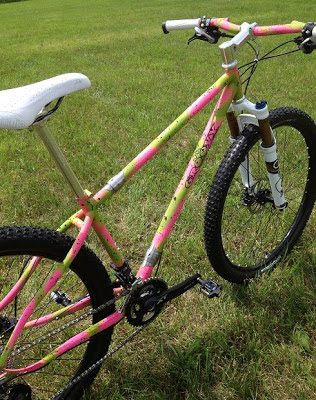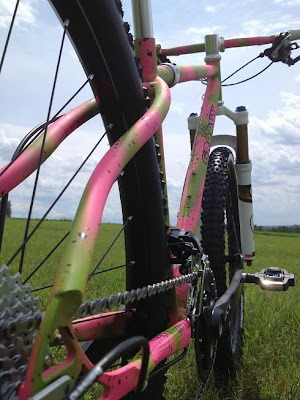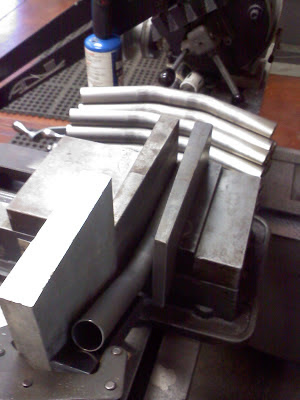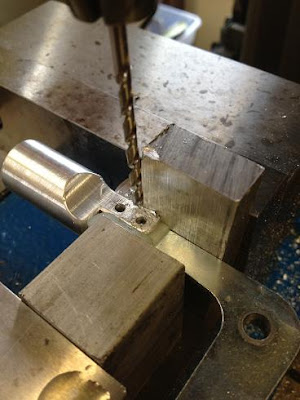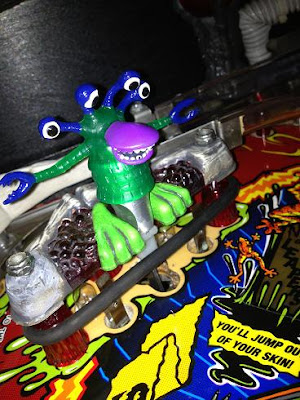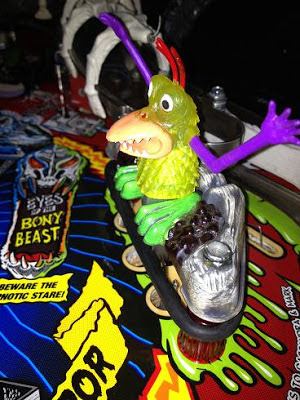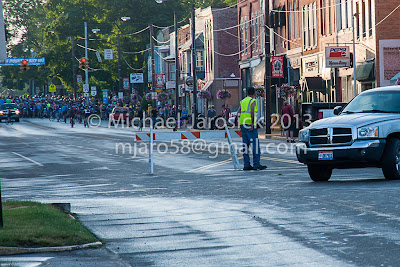Designed for geared or Rohloff use, enjoy the pics...
Tuesday, June 18, 2013
Monday, June 17, 2013
For posterities sake... why no 31.8???
Each week we receive several emails asking if we will produce our steel and titanium bars in 31.8mm center sizing. Each week, our answer is the same; no.
Let me explain why.
For years, the standard for mountain bike handlebars has been a center cross section of 25.4mm or 1.00" diameter tubing. Stems, correspondingly, were sized the same and offered an excellent repository of diverse components to customize your bicycles fit and performance.
When the weight weenie gene began to creep it's way into mountain biking with the introduction of carbon fiber, the game changed. In an effort to keep up with the new kid on the block, Aluminum bar manufacturers began shaving critical material from their bars to save weight, unconsciously moving their durability from sustainable to race oriented. Unfortunately, this race to featherweight components had an irreversible impact on the rider's experience; components, particularly handlebars, were failing. Carbon fiber and the re-spec'd aluminum were not able to deal with the inherent forces of a bicycle hurdling down a single track trail and provide the substantial weight reduction in it's current form. Therefore, a new standard, 31.8mm was born...by increasing the center cross section of the tubing, manufacturers of carbon and aluminum bars were able to increase the contact surface area of the bar, increasing it's strength without impacting the overall weight savings.
Ironically, steel and titanium have the requisite strength and ductility to handle these forces in their current form. By designing with a larger center diameter, it increases the rigidity of the product to a point where it is difficult to provide the desired impact absorption and rider comfort over it's length.
The design of the Luv handle is a three piece mitered and welded product.
The grip section of every mountain bike handlebar requires a .875" outer diameter to appropriately fit provided controls. The center section of the handlebar must be swaged or squeezed into an oval shape to .825" to be properly fitted at the connecting joint. Using the 1.00" tubing, this creates a gentle change in shape which reduces stress on the welded parts and creates a larger welding surface over the grip section, fine tuning the rigidity of the bar.
If I was to move to a 31.8mm standard, it creates two issues;
The first is that the swaging process would have to be much more dramatic to reach the .825" cross section at the end of the center pieces. This process would create two distinct peaks in the oval section, which would eventually serve as focal points for the stress in the bar and provide a failure point, reducing long term durability. This is a compromise I am unwilling to make.
The second issue is that the final product, with the greater diameter center section, would not allow enough flexion over it's length to provide the comfort and control necessary. While it may be fine for those running squishy forks, customers who desire a fully rigid set up would be beat to a pulp.
So, here it is. If you would like a Luv handle you have some options.
- Source a 1.00" clamp section stem, there are lots of them out there cheapish now as they are no longer in vogue.
- Purchase a shim to fit the 1.00" center into a 31.8mm stem.
- Purchase a complete custom bicycle build and I'll make you a one piece bar/stem combo with a perfect fit and lighter weight than you could ever achieve with individual components.
I guess I'm stubborn...I refuse to follow current trends in design just to accommodate weaker materials that provide less durability for perceived weight savings.
rody
Let me explain why.
For years, the standard for mountain bike handlebars has been a center cross section of 25.4mm or 1.00" diameter tubing. Stems, correspondingly, were sized the same and offered an excellent repository of diverse components to customize your bicycles fit and performance.
When the weight weenie gene began to creep it's way into mountain biking with the introduction of carbon fiber, the game changed. In an effort to keep up with the new kid on the block, Aluminum bar manufacturers began shaving critical material from their bars to save weight, unconsciously moving their durability from sustainable to race oriented. Unfortunately, this race to featherweight components had an irreversible impact on the rider's experience; components, particularly handlebars, were failing. Carbon fiber and the re-spec'd aluminum were not able to deal with the inherent forces of a bicycle hurdling down a single track trail and provide the substantial weight reduction in it's current form. Therefore, a new standard, 31.8mm was born...by increasing the center cross section of the tubing, manufacturers of carbon and aluminum bars were able to increase the contact surface area of the bar, increasing it's strength without impacting the overall weight savings.
Ironically, steel and titanium have the requisite strength and ductility to handle these forces in their current form. By designing with a larger center diameter, it increases the rigidity of the product to a point where it is difficult to provide the desired impact absorption and rider comfort over it's length.
The design of the Luv handle is a three piece mitered and welded product.
The grip section of every mountain bike handlebar requires a .875" outer diameter to appropriately fit provided controls. The center section of the handlebar must be swaged or squeezed into an oval shape to .825" to be properly fitted at the connecting joint. Using the 1.00" tubing, this creates a gentle change in shape which reduces stress on the welded parts and creates a larger welding surface over the grip section, fine tuning the rigidity of the bar.
If I was to move to a 31.8mm standard, it creates two issues;
The first is that the swaging process would have to be much more dramatic to reach the .825" cross section at the end of the center pieces. This process would create two distinct peaks in the oval section, which would eventually serve as focal points for the stress in the bar and provide a failure point, reducing long term durability. This is a compromise I am unwilling to make.
The second issue is that the final product, with the greater diameter center section, would not allow enough flexion over it's length to provide the comfort and control necessary. While it may be fine for those running squishy forks, customers who desire a fully rigid set up would be beat to a pulp.
So, here it is. If you would like a Luv handle you have some options.
- Source a 1.00" clamp section stem, there are lots of them out there cheapish now as they are no longer in vogue.
- Purchase a shim to fit the 1.00" center into a 31.8mm stem.
- Purchase a complete custom bicycle build and I'll make you a one piece bar/stem combo with a perfect fit and lighter weight than you could ever achieve with individual components.
I guess I'm stubborn...I refuse to follow current trends in design just to accommodate weaker materials that provide less durability for perceived weight savings.
rody
Friday, June 14, 2013
Flamey Luv only a fire guy could possess...
I'm not a flame kinda guy, but a career fireman wanted a Luv handle with a custom paint job to pay tribute to his profession, so I could not refuse. Here was the process...
I began by shooting a couple coats of sanded primer, followed by two coats of metallic silver. While that was flashing off, I drew up some flames in two dimensions; one set to wrap the grip section and a second set for the larger center section. The plotter will cut wherever you see a line, so the line in the middle will aid in pealing the masking away from the center of the bar, easing the process.
The masking is placed on the bar, allowing the flames to wrap up both sides towards the top...
I then sprayed a gloss black down and removed the mask...
Airbrushed layers of candy yellow, orange, and red then followed, blending in the colors. I then removed the Groovy masking and a maltese cross I made to represent the fire department. A steady hand and extra glasses make this possible as the paint is still wet at this point...
Three coats of clear are then shot over the entire bar and it is constantly rotated to prevent runs and give a uniform finish...
Ta-Dah!
I began by shooting a couple coats of sanded primer, followed by two coats of metallic silver. While that was flashing off, I drew up some flames in two dimensions; one set to wrap the grip section and a second set for the larger center section. The plotter will cut wherever you see a line, so the line in the middle will aid in pealing the masking away from the center of the bar, easing the process.
The masking is placed on the bar, allowing the flames to wrap up both sides towards the top...
I then sprayed a gloss black down and removed the mask...
Airbrushed layers of candy yellow, orange, and red then followed, blending in the colors. I then removed the Groovy masking and a maltese cross I made to represent the fire department. A steady hand and extra glasses make this possible as the paint is still wet at this point...
Three coats of clear are then shot over the entire bar and it is constantly rotated to prevent runs and give a uniform finish...
Ta-Dah!
Wednesday, June 12, 2013
Boogie, damn you!
So I've been promising the kids that someday I'd make a mod for our pinball machine that would allow little monsters to dance and move when the ball strikes the slinghot above the flippers. Our pin, Scared Stiff, originally was designed to include this function, but the dancing boogiemen was cut during production to save money. With Kalten leaving for college in a few mere weeks, the pressure to start following through on a few promises was pressing, so off I went.
What I wanted to do was create an extension to the slingshot crank arm that would allow me to add a little monster finger puppet that would move with the slingshot. To do so, I took some scrap 6061 aluminum and got to work.
First I turned it down in the lathe...
Then I bored it out to reduce it's weight and create a little suction to keep the puppet from flying off
Then I took a 1.00" end mill and relieved both sides and the back to provide for clearance on the slingshot plastic and playfield...
After some additional machining, I had the extension done and then drilled and tapped it to attach it to the slingshot crank arm...
The plastic slingshot covers were broken and looking bad, so I created custom internal metal supports and used epoxy to attach them, cured in the bake box, and then painted to match...
The finished product...
One promise down, countless more to go... :)
What I wanted to do was create an extension to the slingshot crank arm that would allow me to add a little monster finger puppet that would move with the slingshot. To do so, I took some scrap 6061 aluminum and got to work.
First I turned it down in the lathe...
Then I bored it out to reduce it's weight and create a little suction to keep the puppet from flying off
Then I took a 1.00" end mill and relieved both sides and the back to provide for clearance on the slingshot plastic and playfield...
After some additional machining, I had the extension done and then drilled and tapped it to attach it to the slingshot crank arm...
The plastic slingshot covers were broken and looking bad, so I created custom internal metal supports and used epoxy to attach them, cured in the bake box, and then painted to match...
The finished product...
One promise down, countless more to go... :)
Thursday, June 6, 2013
Mohican 100 pics...
Attention Mohican 100 participants...loyal Groovy patron and good friend Mike Jarosick was out on the course during the race refining his cycling pictorial skills. He has a repository of great racing pics, perhaps of you. Please check them out and contact Mike if you'd like a print...
Mohican 100 2013 pics here...
Monday, June 3, 2013
Ceramic coatings, a few thoughts...
I've been spraying a lot more ceramic due to my desire to push the finish in our industry as I feel it answers many of the negative characteristics found in liquid paint and powder. It is very thin, scratch resistant, light weight, and bonds to the substrate at the molecular level.
Due to this, I've fielded a number of inquiries from other builders, so I thought that I'd share a few thoughts from a post on VS about prepping a frame for ceramic.
As with any finish, the most important item you need to focus on is the aesthetic you desire of the final product. The required elements to achieve that can be sorted from there.
If you are sending out your frame, communication with the finisher is key. Insure that your vision of the final product is clearly understood by the contracted finisher, that both you and he are confident it can be achieved, and then request his pre-requisites for the frame preparation before shipping as each individual's abilities and equipment vary.
With ceramic, the fabricator needs to understand that it builds and covers less than any other applied finish, around .001". This means that any imperfection in the frame will be visible in the final finish. There is no hiding stray file marks, irregular tig beads, or that tiny run of silver that you thought you filed smooth. I would suggest carefully inspecting your frame, if questionable areas are found, spray a little krylon grey primer over the area and allow it to flash dry. This will magnify any imperfections so you may take corrective action while being easily removed. Once satisfied, we can move on to the next step.
Go ahead and ream/face/tap/final prep all your critical areas. The ceramic builds so thin that these potential finish marring actions can be completed beforehand allowing you to move to assembly upon receiving your product back. After completion, wipe up all remaining tapping/cutting fluid, rinse well with a quick evaporating solvent (acetone or ISO alcohol), and then blow out the entire frame with compressed, filtered air.
Your applicator will media blast the frame, place it in a solvent bath, fume off the frame in an oven or bake box, then apply your ceramic finish.
While not difficult to apply, the range of variables in carrier/suspension/hardener can result in vastly different visual finishes, making this a truly fun product to work with. This also makes it extremely fussy dependent on the experience of the applicator, insure that he is comfortable with the medium, specifically with thin walled bicycle tubing which can and will create nuances in bake time.
I've spoken here and in other media about additional factors, such as positive and negative masking, cure times when working with multiple colors, etc, so we are getting a pretty good resource compiled.
Here are some pics of the latest ceramic finish, an aluminum fat bike frame I did for a friend that owns a local shop who is thinking about contracting his own line of bikes. This finish incorporates multiple colors, masking with bare AL, and custom graphics... check it out!
cheers,
rody
Due to this, I've fielded a number of inquiries from other builders, so I thought that I'd share a few thoughts from a post on VS about prepping a frame for ceramic.
As with any finish, the most important item you need to focus on is the aesthetic you desire of the final product. The required elements to achieve that can be sorted from there.
If you are sending out your frame, communication with the finisher is key. Insure that your vision of the final product is clearly understood by the contracted finisher, that both you and he are confident it can be achieved, and then request his pre-requisites for the frame preparation before shipping as each individual's abilities and equipment vary.
With ceramic, the fabricator needs to understand that it builds and covers less than any other applied finish, around .001". This means that any imperfection in the frame will be visible in the final finish. There is no hiding stray file marks, irregular tig beads, or that tiny run of silver that you thought you filed smooth. I would suggest carefully inspecting your frame, if questionable areas are found, spray a little krylon grey primer over the area and allow it to flash dry. This will magnify any imperfections so you may take corrective action while being easily removed. Once satisfied, we can move on to the next step.
Go ahead and ream/face/tap/final prep all your critical areas. The ceramic builds so thin that these potential finish marring actions can be completed beforehand allowing you to move to assembly upon receiving your product back. After completion, wipe up all remaining tapping/cutting fluid, rinse well with a quick evaporating solvent (acetone or ISO alcohol), and then blow out the entire frame with compressed, filtered air.
Your applicator will media blast the frame, place it in a solvent bath, fume off the frame in an oven or bake box, then apply your ceramic finish.
While not difficult to apply, the range of variables in carrier/suspension/hardener can result in vastly different visual finishes, making this a truly fun product to work with. This also makes it extremely fussy dependent on the experience of the applicator, insure that he is comfortable with the medium, specifically with thin walled bicycle tubing which can and will create nuances in bake time.
I've spoken here and in other media about additional factors, such as positive and negative masking, cure times when working with multiple colors, etc, so we are getting a pretty good resource compiled.
Here are some pics of the latest ceramic finish, an aluminum fat bike frame I did for a friend that owns a local shop who is thinking about contracting his own line of bikes. This finish incorporates multiple colors, masking with bare AL, and custom graphics... check it out!
cheers,
rody
Subscribe to:
Posts (Atom)


